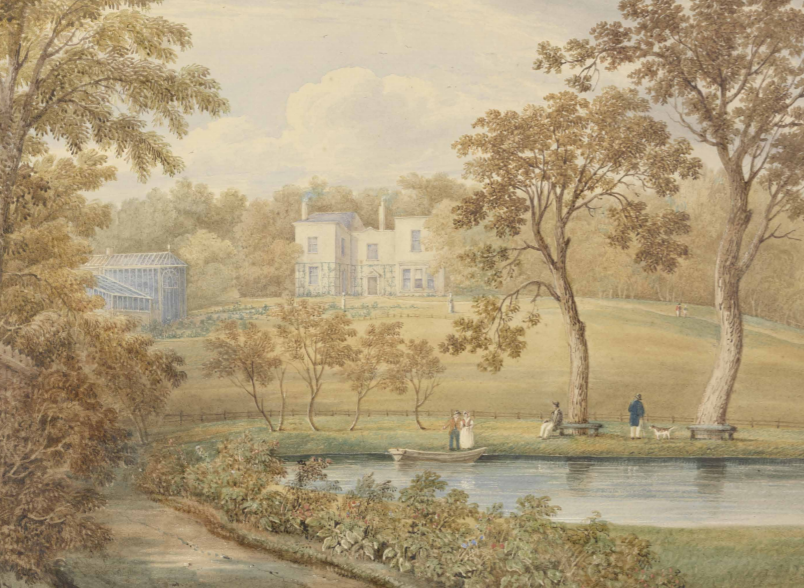Hardy Plants and Plantings for Repton and Late Georgian Gardens (1780-1820)

|
| Hardy Plants and Plantings for Repton and Late Georgian Gardens (1780-1820), Sarah Rutherford, Historic England, Research Report Series No 20-2018, 39 pages, 21 colour and black and white illustrations, available as a free-to-download 5.31 MB pdf file at http://research.historicengland.org.uk/Report.aspx?i=16017 |
In 2018, the garden history world focused on Humphry Repton (1752–1818), the great landscape designer and successor to Lancelot ‘Capability’ Brown (1716-83). This report aims to provide a starting point for anyone involved with planting, managing or researching a late-Georgian garden, and a contribution to the celebrations.
Repton was not the only designer in the period, but he was prolific and a great self-publicist, leaving a legacy of books and individual reports to clients. The reports, often bound in red leather and now known as Red Books, included watercolours with lift-up flaps showing scenes before and after implementation of his advice. Often his advice was not followed.
Although skilled in proposed effects, Repton was no plantsman. He and others published little detailed planting advice. The report aims to remedy this by considering plants available in the period and how they were used, and sources for further research. Garden historian and Kew-trained Sarah Rutherford rises to the challenge. She has prepared many conservation plans, including one for Ashridge (Repton’s Red Book partly illustrates the report), and her books include ‘Capability Brown’ and ‘The Arts and Crafts Garden’.
An overview of garden design in 1780-1820 includes the return (where it ever went away) of the flower garden around the house and the need for elegant gardens to complement the many new smaller houses in pared-down classical style. The numerous picturesque cottages ornés are not specifically mentioned, although Endsleigh in Devon is illustrated.
The standard palette was augmented by many, at first expensive, plants introduced from exotic places. The new planting style was to mass plants of the same type for visual impact. Shrubberies became distinctive features with splashes of colour and year-round interest. Separate themed areas included the specialist rose garden. The modern publications of Mark Laird, Mavis Batey and John Harvey are correctly highlighted as essential resources.
The main section lists 338 ornamental hardy plants available in Britain between 1780 and 1820, and still readily available, grouped by type with Latin and common names, some dates of introduction and notes on colour. The list is obviously drawn from many sources, including (it can be deduced) a 1778 seed catalogue. The researcher would have welcomed details of sources and criteria. The snap dragon introduced ‘by 1778’ might be mistakenly thought a new exotic (elsewhere John Harvey gives a date of c1500).
Three case studies, Brighton Royal Pavilion, a Jersey town house and the Ashridge flower garden, are described. Planting lists for the last two include later varieties to produce a period effect. This highlights a point, not discussed, that planting is inevitably re-creation rather than restoration, a term sometimes confused. The references of primary and secondary sources for further research demonstrate the wealth of information readily available, although with critical appraisal wisely advised.
Given such a concise summary of current knowledge and horticultural experience, some quibbles are inevitable. Overall, for any late Georgian garden project this report is a very good starting point and a useful checklist for the future.
You can download the report at http://research.historicengland.org.uk/Report.aspx?i=16017
This article originally appeared in IHBC's Context 156 (Page 53), published in September 2018. It was written by Helen Thomas, a retired architect and historic designed landscape consultant.
--Institute of Historic Building Conservation
Related articles on Designing Buildings Wiki
- Capability Brown.
- Conservation.
- Conserving and managing historic designed landscapes.
- Conserving structures in historic designed landscapes.
- Garden.
- Georgian.
- Heritage.
- IHBC articles.
- Landscape architect.
- Landscape design.
- Oxford College Gardens and Cambridge College Gardens.
- Picturesque movement.
- Sharawadgi.
- The Institute of Historic Building Conservation.
- The secret life of the Georgian garden.
- Walled kitchen gardens of the Isle of Wight.
- Worcester’s Georgian churches.
IHBC NewsBlog
Purcell’s guidance on RAAC for Listed Buildings in England & Wales
The guidance specifically focuses on Reinforced Autoclaved Aerated Concrete (RAAC) in listed buildings.
IHBC Membership Journal Context - Latest Issue on 'Hadrian's Wall' Published
The issue includes takes on the wall 'end-to-end' including 'the man who saved it'.
Heritage Building Retrofit Toolkit developed by City of London and Purcell
The toolkit is designed to provide clear and actionable guidance for owners, occupiers and caretakers of historic and listed buildings.
70 countries sign Declaration de Chaillot at Buildings & Climate Global Forum
The declaration is a foundational document enabling progress towards a ‘rapid, fair, and effective transition of the buildings sector’
Bookings open for IHBC Annual School 12-15 June 2024
Theme: Place and Building Care - Finance, Policy and People in Conservation Practice
Rare Sliding Canal Bridge in the UK gets a Major Update
A moveable rail bridge over the Stainforth and Keadby Canal in the Midlands in England has been completely overhauled.
'Restoration and Renewal: Developing the strategic case' Published
The House of Commons Library has published the research briefing, outlining the different options for the Palace of Westminster.
Brum’s Broad Street skyscraper plans approved with unusual rule for residents
A report by a council officer says that the development would provide for a mix of accommodation in a ‘high quality, secure environment...
English Housing Survey 2022 to 2023
Initial findings from the English Housing Survey 2022 to 2023 have been published.
Audit Wales research report: Sustainable development?
A new report from Audit Wales examines how Welsh Councils are supporting repurposing and regeneration of vacant properties and brownfield sites.
















